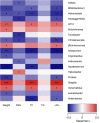Gut microbiota mediates positive effects of liraglutide on dyslipidemia in mice fed a high-fat diet
- PMID: 36643973
- PMCID: PMC9835552
- DOI: 10.3389/fnut.2022.1048693
Gut microbiota mediates positive effects of liraglutide on dyslipidemia in mice fed a high-fat diet
Abstract
Except for improving glycemic control, liraglutide, one of the glucagon-like peptide-1 receptor agonists, has exerted promising therapeutic effects for dyslipidemia. It has been proved that gut microbiota plays a dramatic role in regulating lipid metabolism. This study aims to explore whether liraglutide could improve dyslipidemia by modulating the gut microbiota in mice fed a high-fat diet (HFD). The C57BL/6 mice were fed a HFD to establish an animal model of dyslipidemia, and then administered with liraglutide or normal saline (NS) for 12 weeks. Indices of glucolipid metabolism were evaluated. Gut microbiota of the mice was analyzed by 16S rRNA gene sequencing. Compared with HFD group, liraglutide significantly alleviated weight, total cholesterol (TC) and low-density lipoprotein cholesterol (LDL) levels, meanwhile elevating high-density lipoprotein cholesterol (HDL) levels (all p < 0.05). The gut microbiota analysis revealed that liraglutide greatly reduced the relative abundance of Firmicutes and augmented that of Bacteroidetes, with a concomitant drop in the Firmicutes/Bacteroidetes ratio. Meanwhile, liraglutide dramatically changed the overall composition, promoted the growth of beneficial microbes (Akkermansia, Lactobacillus, Parabacteroides, Oscillospira, etc.), and inhibited the growth of harmful microbes (AF12, Shigella, Proteobacteria, Xenorhabdus, etc.). Especially, the relative abundance of Akkermansia increased the most after liraglutide treatment. Correlation analysis suggested that TC and LDL were positively correlated with some harmful bacteria, and negatively associated with beneficial bacteria. This study confirmed that liraglutide had a certain therapeutic effect on dyslipidemia in HFD-fed mice and could regulate the composition of the gut microbiota associated with lipid metabolism, especially Akkermansia. Thus, affecting gut microbiota might be a potential mechanism of liraglutide in attenuating dyslipidemia.
Keywords: Akkermansia; dyslipidemia; glucagon-like peptide-1 receptor agonist; gut microbiota; liraglutide.
Copyright © 2022 Zhao, Qiu, Zhang, Wu, Zhao, Deng, Yang, Wang and Yuan.
Conflict of interest statement
The authors declare that the research was conducted in the absence of any commercial or financial relationships that could be construed as a potential conflict of interest.
Figures





Similar articles
-
Sexual Dimorphism in Lipid Metabolism and Gut Microbiota in Mice Fed a High-Fat Diet.Nutrients. 2023 May 2;15(9):2175. doi: 10.3390/nu15092175. Nutrients. 2023. PMID: 37432375 Free PMC article.
-
Orlistat and ezetimibe could differently alleviate the high-fat diet-induced obesity phenotype by modulating the gut microbiota.Front Microbiol. 2022 Aug 15;13:908327. doi: 10.3389/fmicb.2022.908327. eCollection 2022. Front Microbiol. 2022. PMID: 36046024 Free PMC article.
-
The polyphenol-rich extract from chokeberry (Aronia melanocarpa L.) modulates gut microbiota and improves lipid metabolism in diet-induced obese rats.Nutr Metab (Lond). 2020 Jul 7;17:54. doi: 10.1186/s12986-020-00473-9. eCollection 2020. Nutr Metab (Lond). 2020. PMID: 32655675 Free PMC article.
-
Anti-Hyperlipidemia and Gut Microbiota Community Regulation Effects of Selenium-Rich Cordyceps militaris Polysaccharides on the High-Fat Diet-Fed Mice Model.Foods. 2021 Sep 23;10(10):2252. doi: 10.3390/foods10102252. Foods. 2021. PMID: 34681302 Free PMC article.
-
Protective effect of hydroxychloroquine on rheumatoid arthritis-associated atherosclerosis.Animal Model Exp Med. 2019 Apr 19;2(2):98-106. doi: 10.1002/ame2.12065. eCollection 2019 Jun. Animal Model Exp Med. 2019. PMID: 31392302 Free PMC article. Review.
Cited by
-
Sexual Dimorphism in Lipid Metabolism and Gut Microbiota in Mice Fed a High-Fat Diet.Nutrients. 2023 May 2;15(9):2175. doi: 10.3390/nu15092175. Nutrients. 2023. PMID: 37432375 Free PMC article.
-
Gut microbiota and therapy for obesity and type 2 diabetes.Front Endocrinol (Lausanne). 2024 Mar 26;15:1333778. doi: 10.3389/fendo.2024.1333778. eCollection 2024. Front Endocrinol (Lausanne). 2024. PMID: 38596222 Free PMC article. Review.
-
Understanding the complex function of gut microbiota: its impact on the pathogenesis of obesity and beyond: a comprehensive review.Diabetol Metab Syndr. 2024 Dec 23;16(1):308. doi: 10.1186/s13098-024-01561-z. Diabetol Metab Syndr. 2024. PMID: 39710683 Free PMC article. Review.
-
Effects of GLP-1 Analogues and Agonists on the Gut Microbiota: A Systematic Review.Nutrients. 2025 Apr 9;17(8):1303. doi: 10.3390/nu17081303. Nutrients. 2025. PMID: 40284168 Free PMC article.
-
Potential Modulatory Roles of Gut Microbiota and Metabolites in the Associations of Macronutrient-to-Physical Activity Ratios With Dyslipidemia.J Am Heart Assoc. 2025 May 20;14(10):e040042. doi: 10.1161/JAHA.124.040042. Epub 2025 May 15. J Am Heart Assoc. 2025. PMID: 40371613 Free PMC article.
References
-
- Opoku S, Gan Y, Fu W, Chen D, Addo-Yobo E, Trofimovitch D, et al. Prevalence and risk factors for dyslipidemia among adults in rural and urban China: findings from the China National Stroke Screening and prevention project (CNSSPP). BMC Public Health. (2019) 19:1500. 10.1186/s12889-019-7827-5 - DOI - PMC - PubMed
-
- Karr S. Epidemiology and management of hyperlipidemia. Am J Manag Care. (2017) 23 (9 Suppl.):S139–48. - PubMed
-
- Tong X, Xu J, Lian F, Yu X, Zhao Y, Xu L, et al. Structural alteration of gut microbiota during the amelioration of human type 2 diabetes with hyperlipidemia by metformin and a traditional chinese herbal formula: a multicenter, randomized, open label clinical trial. mBio. (2018) 9:e2392-17. 10.1128/mBio.02392-17 - DOI - PMC - PubMed
LinkOut - more resources
Full Text Sources
Miscellaneous

